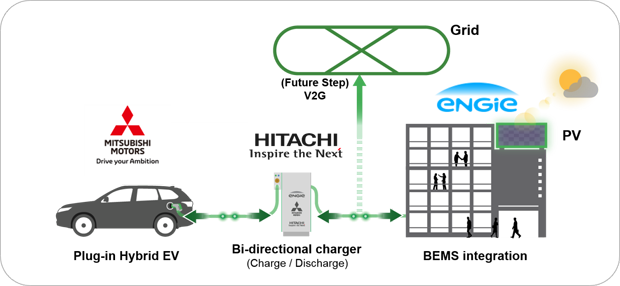LONDON / ZAANDAM / TOKYO; March 29, 2018 – Hitachi Europe Ltd., Mitsubishi Motors and ENGIE have demonstrated a pioneering project to explore the potential for electric vehicles to act as a means of energy storage for an office building. For this demonstration, the consortium linked the first vehicle to everything (V2X) charger to ENGIE's office building in Zaandam.
Hitachi's innovative V2X Charger is the first recharger that cannot only recharge an electric car but can also discharge the energy back into the building/grid providing different flexibilities including kW, ΔkW, kWh and VAR. Moreover, it is possible to connect solar panels and external storage directly to the recharger, allowing a much more efficient electricity supply to buildings.
With buildings and transport together accounting for about 75% of the total CO2 emissions of a service providing company, vehicle to building (V2B) technology can play a crucial role in reducing carbon emissions around the world, whilst also helping buildings and companies to lower their energy costs.
Bringing together respective expertise, Mitsubishi Motors, ENGIE and Hitachi believe that an innovative vehicle to building (V2B) charging station can lead to more intelligent and efficient building energy management systems.
The V2X Charger is connected to the building's energy supply and, when the building generates more solar power than it needs, this excess energy is stored in the battery of the electric car. This energy can then be discharged back into the grid when appropriate. The car battery therefore acts as an energy storage source, as well as an emergency power supply.
In collaborating, the companies contribute their capabilities in the following areas:
- Hitachi is providing its V2X charger, which enables bi-directional charging between the electric car battery and the building or electricity grid. It is also supplying the technology which enables the integration of energy between the vehicle and the building, and the vehicle and the electricity grid.
- ENGIE creates a Smart Building by connecting the battery inside the electric car via a V2X Charger to the building's energy supply system and integrate it with solar panels or other renewable energy sources within the smart grid.
- Mitsubishi Motors is providing its Outlander PHEV SUV to act as an energy storage center that building power systems can utilize to access a stable supply of renewable energy.
For the next stage of the project, the consortium will examine how electric vehicles, renewable energy and Building Energy Management Systems can work together to enable buildings to become energy-neutral. This leads to intelligent and more efficient microgrids that can interact with building energy management systems (BEMS). Using the available energy in the smartest possible way reduces a company's emissions and saves costs.
Highlighting the benefits of deploying digital energy technologies, Ram Ramachander, Chief Digital Officer at Hitachi Europe, said:
"This project demonstrates how our IoT and digital capabilities can help customers make buildings energy-neutral, increasing their energy efficiency and reducing costs, by optimizing EV charging infrastructure. Our technology can also help to create new business cases across the EV value chain, including vehicle to grid technology, which enables flexibility with their energy distribution".
Commenting on the ambitious scheme, Hans Boot, COO at ENGIE Services Netherlands, stated:
"This project provides a powerful demonstration of the outstanding effectiveness of energy storage technology. This charger exceeds smart charging as we know it and is basically the first real 'smart grid charger'. We hope to begin installing this system for all companies who are eager to take the next step towards becoming truly energy-neutral."
Discussing the growing role for electric vehicles in powering the development of smart cities, Vincent Cobee, Corporate Vice President at Mitsubishi Motors, added:
"This demonstration will help providing a new energy solution for energy efficient, low carbon smart buildings. We are aiming to show that EVs and PHEVs can be a vital component of urban energy in the future. "
About Mitsubishi Motors Corporation (MMC)
Mitsubishi Motors is a global automobile company based in Tokyo, Japan, which has a competitive edge in SUVs and pickup trucks, electric and plug-in hybrid vehicles, as well as the ASEAN region. The company launched i-MiEV – the first mass-produced electric vehicle – in 2009, which was followed with Outlander PHEV in 2013 – the world's best-selling plug-in hybrid SUV . Mitsubishi has 30,000 employees and a global footprint with production facilities in Japan, Thailand, China, Indonesia, The Philippines and Russia. Models such as the Pajero Sport/Montero Sport, Triton/L200 and Outlander play a major role in achieving its growth. Global sales volume in fiscal year 2016 was 926,000 units, and Mitsubishi's net sales for fiscal year 2016 were 1.9 trillion yen.
About Hitachi Europe Ltd.
Hitachi Europe Ltd., a subsidiary of Hitachi, Ltd., is headquartered in Maidenhead, UK. The company is focused on its Social Innovation Business - delivering innovations that answer society's challenges. Hitachi Europe and its subsidiary companies offers a broad range of information & telecommunication systems; rail systems, power and industrial systems; industrial components & equipment; automotive systems, digital media & consumer products and others with operations and research & development Laboratories across EMEA. For more information, visit http://www.hitachi.eu.
About ENGIE
ENGIE develops its businesses (power, natural gas, energy services) around a model based on responsible growth to take on the major challenges of energy's transition to a low-carbon economy: access to sustainable energy, climate-change mitigation and adaptation and the rational use of resources. The Group provides individuals, cities and businesses with highly efficient and innovative solutions largely based on its expertise in four key sectors: renewable energy, energy efficiency, liquefied natural gas and digital technology. ENGIE employs 153,090 people worldwide and achieved revenues of €69.6 billion in 2016.
